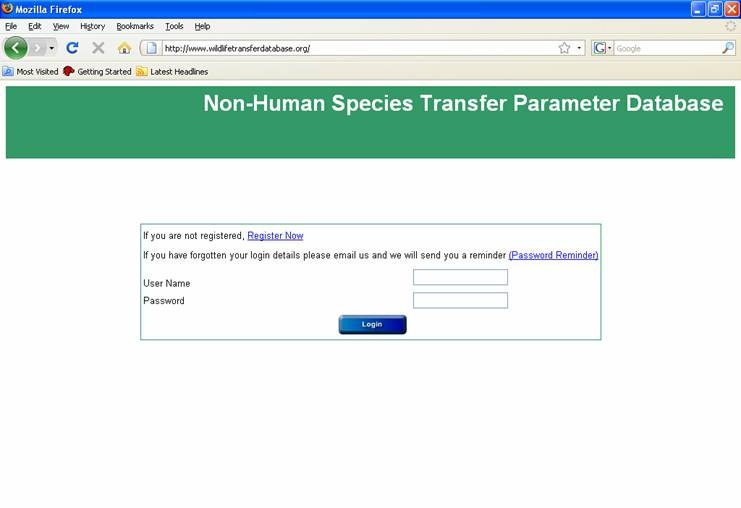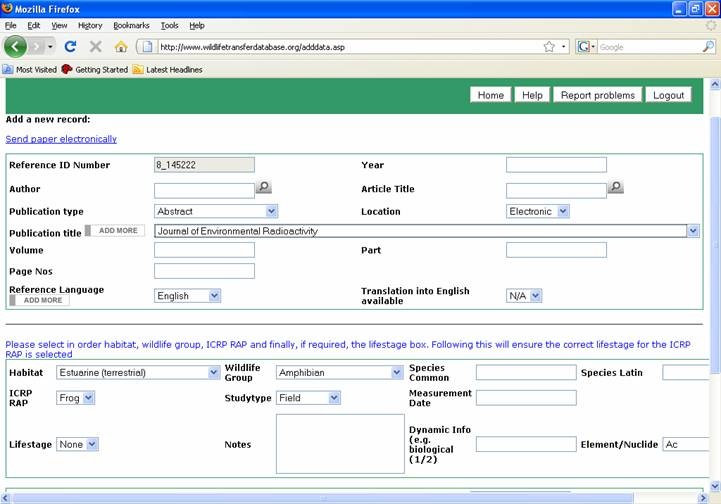Page History
...
Wildlife
...
Transfer
...
Database
...
http://www.wildlifetransferdatabase.org/
A number of evaluations of the available approaches to estimating the exposure of wildlife to ionising radiation have concluded that the estimation of wholebody activity concentrations (using transfer models) contributes most to the overall uncertainty of the dose rate predictions (for instance see outputs of the IAEA EMRAS Biota Working Group and the EC funded PROTECT consortium).
Acting on such findings the IAEA EMRAS II programmes Working Group 5 has been working to collate data on the transfer of radionuclides to wildlife to support the production of a Technical Report Series handbook, in collaboration with the IUR and an ICRP Task Group, using an online database (click to access) to collate and summarise data. The database has been designed and supported by the: Environment Agency, England and Wales; Centre for Ecology and Hydrology (UK); Norwegian Radiation Protection Authority; Natural Environment Research Council (UK).
The purpose of the database is to provide parameter values for use in environmental radiological assessments to estimate the transfer of radioactivity to non-human biota (i.e. ‘wildlife’) including the derivation of transfer parameter values for the International Commission on Radiological Protections (ICRP) list of Reference Animals and Plants (RAPs). Wildlife is defined here to include all non-domesticated plants,animals and other organisms including feral species (i.e. non-native self-sustaining populations).
UPDATE: The IAEA TRS and ICRP reports have now been submitted for publication. If you log-on to the database you will find that we have provided link to two MSExcel files which contain the extracted data for (i) wildlife category as used in the IAEA TRS and (ii) ICRP RAPs. These were output from the database as of February 2011. Please note that these data were used as the basis for completion of the final IAEA and ICRP reports but there will be some differences between the data tables provided and their presentation in the IAEA and ICRP reports (mainly because we were able to subdivide the data further into smaller wildlife groups in some cases and some element/organism combinations were not included). Download summary tables option will take you to these tables.
It is hoped that the database will provide an evolving source of up to date information to those conducting assessments and developing/maintaining models as more data are added.
| Align | ||
|---|---|---|
| ||
Your assistance in populating the database with any suitable data on concentration ratios that you may have would be welcomed. |
The links below will take you to the user guidance document for the database, advice on how to convert tissue specific to whole-organism activity concentrations, and various files providing advice on how organisms have been categorised within the database.
The help file to the online database can be accessed
| Newwindow | ||||
|---|---|---|---|---|
| ||||
]{color} {color:#800000}{*}NOTE: June 2011 - The database is now back on-line\! *{color} A number of evaluations of the available approaches to estimating the exposure of wildlife to ionising radiation have concluded that the estimation of wholebody activity concentrations (using transfer models) contributes most to the overall uncertainty of the dose rate predictions (for instance see outputs of the [IAEA EMRAS Biota Working Group|iaea] and the EC funded [PROTECT] consortium). Acting on such findings the [IAEA EMRAS II|http://www-ns.iaea.org/projects/emras/emras2/default.htm] programmes [Working Group 5|http://www-ns.iaea.org/projects/emras/emras2/working-groups/working-group-five.htm] is working to collate data on the transfer of radionuclides to wildlife to support the production of a [Technical Report Series|http://www-pub.iaea.org/MTCD/publications/ResultsPage.asp] handbook. In collaboration with the IUR, the EMRAS II Working Group is using an online database ([click|http://www.wildlifetransferdatabase.org/] to access) to collate and summarise data. The database has been designed and supported by the: Environment Agency, England and Wales; Centre for Ecology and Hydrology (UK); Norwegian Radiation Protection Authority; Natural Environment Research Council (UK). {align:center}{color:#ff0000}{*}Your assistance in populating the{*}{color} {color:#ff0000}*[database|http://www.wildlifetransferdatabase.org/]*{color} {color:#ff0000}{*}with any suitable data on concentration ratios that you may have would be welcomed{*}{color}. \\ {align}Once you have registered to use the database, there is a help/guidance document available which explains what information is being requested how to navigate within the website and complete the database fields. Please note that we will be continuing to modify the design of the website. \\ (i) *The* {color:#ff6600}{*}help file{*}{color} *to the online database can be accessed* {newwindow:here.}https://wiki.ceh.ac.uk/download/attachments/115016189/CRdatabasehelpon-line.pdf{newwindow}{*}The help file is regularly updated,* {color:#0000ff}{*}version |
The help file is regularly updated, version 1.12
...
(15/09/2011)
...
is
...
the
...
current
...
version.
...
How to categorise freshwater species by online database wildlife group and as ICRP RAPS (contains information for all species included in the database to date). Version 4th October 2011. For fish http://www.fishbase.org/ is a useful source of information.
How to categorise marine and estuarine (brackishwater) species by online database wildlife group and as ICRP RAPS (contains information for all species included in the database to date). Version 31st March 2012.
How to categorise terrestrial species by database wildife group and as ICRP RAPS (contains information for all species included in the database to date). Version 16th September 2011. A useful link for confirming/finding any new scientific names added to the database can be found on the National Biodiversity Gateway. Type species name into search box (can be common name) and on the results page select Taxonomic information for Scientific Name.
How to convert tissue specific activity concentrations to wholebody values.
Spreadsheet enabling analyses of summarised datasets. ADDED 29-May-2013
We advise that you use Internet Explorer to access the database.
If you have any queries on how to use the database or find any problems with it please contact either Nick Beresford or David Copplestone.
Please forward the website details on to anyone else you think might have suitable data.

